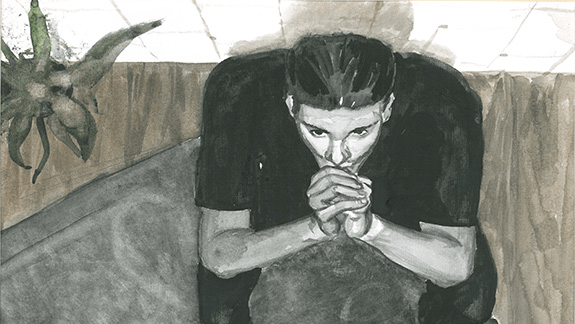
EARLY INTERVENTION IN PSYCHOSES: ASSESSMENT AND TREATMENT TO IMPROVE FUNCTIONAL OUTCOMES
In this section
The session ‘Early Intervention in Psychoses: Assessment and Treatment to Improve Functional Outcomes’ moderated by Professors Armida Mucci and Andrea Raballo at EPA 2021 Virtual aimed to address two important components of early intervention: timely assessment and adequate treatment. To do this, the speakers of the symposium, Professors Merete Nordentoft, Anne Thorup and Elmārs Rancāns discussed why early detection and the alleviation of negative symptoms are crucial as well as what are the best approaches when it comes to polypharmacy.
Early detection and intervention is crucial in negative symptoms
Armida Mucci, Professor of Psychiatry at University of Campania, began her session entitled “Prediction of Drop-out and Functional Impairment in Recent-onset Schizophrenia Spectrum Disorders” by highlighting the importance of negative symptoms in schizophrenia as they are associated with worse functional outcomes. Negative symptoms are regarded as a reduction of normal functions either related to motivation and interest, such as avolition, anhedonia, and asociality, or to expressive functions such as blunted affect and alogia.1 Additionally, they can be primary or secondary, and persistent or transitory, which complicate their detection and diagnosis further.
After this introduction, Professor Mucci turned the focus to persistent negative symptoms (PerNS), which represent an alternative approach for assessing negative symptoms in the context of clinical trials. According to Buchanan, who shaped this approach, PerNS are defined by the presence of negative symptoms of at least moderate severity with a pre-defined threshold of positive symptoms, depression, and extrapyramidal symptoms as measured by any of the accepted and validated rating scales.2 In addition, the persistence of the above described symptoms should be for at least 6 months.2 The differentiation between persistent versus non-persistent negative symptoms is important, Professor Mucci pointed out, because according to the European First Episode Schizophrenia trial,3 patients with PerNS differ from those without; they might experience longer duration of untreated psychosis, are more frequently discontinuing their treatment, have poorer psychopathological outcomes as well as worse global functioning after 1 year of treatment.
In continuing her presentation, Professor Mucci further emphasized that in first-episode patients, negative symptoms are difficult to assess. Frequently, there is almost a universal failure to distinguish primary from secondary negative symptoms, and persistent from transitory, although about half of patients have at least one negative symptom and one-third have unconfounded, primary negative symptoms.3 These symptoms are associated with worse psychosocial functioning, longer duration of psychosis, poor clinical outcome, and resistance to antipsychotic treatment, including clozapine.3 Therefore, detection and early treatment of these symptoms is of utmost importance.
Professor Mucci concluded her presentation by talking about the OPTiMiSE trial which examined treatment algorithms for first episode patients, with the focus on when to switch to clozapine. The trial concluded that “clozapine should be used after patients fail a single antipsychotic trial and not until two antipsychotics have been tried, as is the current recommendation”.4 From this trial, she stressed that in most patients in the early stages of schizophrenia symptomatic remission can be achieved using a simple treatment algorithm comprising the sequential administration of amisulpride and clozapine.
Professor Mucci also highlighted that negative symptoms of moderate severity are observed in the majority of subjects at baseline, and are associated with worse psychosocial functioning and longer duration of psychosis.5 She also clarified that the presence of short-term PerNS during the first phases of psychosis has been further associated with poor clinical outcome and resistance to antipsychotic treatment, including clozapine. Thus, these data may have clinical implications for interventions that specifically target negative symptoms.
The Need to Treat Negative Symptoms in Early Intervention
In the next lecture, Merete Nordentoft, Professor of Clinical Psychiatry at the University of Copenhagen, began by explaining that negative symptoms are challenging for both patients and their relatives since these symptoms are more difficult to grasp and comprehend, but also because outcomes for positive and negative symptoms are different. While positive symptoms show a general pattern of reduction and stabilisation over time, negative symptoms typically show less variation over 10 years.6,7 To support this notion, Prof Nordentoft presented data from the Danish OPUS trial. The aim of the OPUS trial was to look at the course of positive and negative symptoms and find trajectories based on structured clinical assessments collected over 10 years in people with first episode psychosis. The ultimate goal was to help clinicians to develop effective interventions and to improve treatment outcomes based on the results. According to the outcomes of the trial that also evaluated the effects of assertive specialised psychiatric treatment vs. treatment as usual, specialised early intervention can be efficient in treating patients with a first episode of psychosis.6,7
At the end of the session, Professor Nordentoft emphasized the importance of scales for the diagnosis of negative symptoms and pointed out that a new EPA guideline is on its way, with recommendations for assessment tools.8 Importantly, the guidance states that summary scores or subscale scores aiming to assess negative symptoms should only consider core negative symptoms (avolition, anhedonia, asociality, blunted affect and alogia). This specifically applies to sub-scores of older scales such as the PANSS, SANS and BPRS. In fact, it is recommended for these older scales to be complemented with second-generation scales for negatives symptoms such as the Brief Negative Symptom Scale (BNSS) and the Clinical Assessment Interview for Negative Symptoms (CAINS) in future clinical trials.
Assessing children with a parent with psychiatric illness
Assistant professor Anne Thorup, specialist in child and adolescent psychiatry working at University of Copenhagen, began her presentation “The Danish High Risk and Resilience Study: VIA 7, 11 and 15” by stating that growing up with a parent with a psychiatric illness may place children at greater risk for developing a mental health problem of their own since these parents may not always be available when needed and Children may thus experience dangerous events that other peers may not.
To elaborate on this phenomenon, Professor Thorup presented the Danish High Risk and Resilience Study, which enrolled 522 seven-year-old children (VIA 7),9,10 of which 202 had a parent diagnosed with schizophrenia, 120 with bipolar disorder and 200 with no mental illness in the family. 85% of the control children lived with both parents, while this was less for children with bipolar parents (53%) and even less for children with schizophrenic parents (40%). Subsequently, 20% of children with schizophrenic parents were getting less support than what they needed compared to 7% with a bipolar parent and 3% of control children. As a consequence, 37% of children with schizophrenic parents and 36% of those with a bipolar parent met Kiddie Schedule for Affective Disorders and Schizophrenia (K-SADS) criteria for diagnosis of a mental health disorder vs. 15% of controls.
Professor Thorup continued her lecture by presenting longitudinal data from the same study from when the children were 11 years old (VIA 11).11 At 11 years old, the proportion of children with a mental health disorders increased in all groups, but with the differences seen in VIA 7 remained. In addition, more children with a schizophrenic or bipolar parent experienced trauma compared to controls.
Finally, Professor Thorup noted that the study is still ongoing and will assess the same children at age 15 (VIA 15) from April 2021 to March 2024. She thus believes that the VIA study is providing unique and valuable information about children with mentally ill parents.
Antipsychotic polypharmacy is a real-life reality
The last lecture of the symposium was presented by Elmārs Rancāns, Professor at the Department of Psychiatry and Narcology, Faculty of Medicine, Riga, who pointed out that the majority of guidelines recommend antipsychotic monotherapy over polypharmacy as the standard of care.12 Nevertheless, prescribing patterns in real life show that around 20% of patients are receiving antipsychotic combinations, with a first-generation agent together with a second-generation agent preferred in almost 60% of cases.13 Combinations however are associated with higher rates of non-adherence; compared to monotherapy, non-adherence increased significantly with the number of co-prescribed antipsychotic drugs (1.69-fold for two, 2.60-fold for three and 3.54-fold for four or more, respectively).14 Additionally, real-world effectiveness of antipsychotic monotherapy is superior to polypharmacy for sustained long-term treatment.15
On the other hand, Professor Rancans explained, according to a large cohort study of 62,250 patients, antipsychotic polypharmacy was associated with a 7% to 13% lower risk of psychiatric rehospitalisation compared to monotherapy.16 Combining a dopamine partial agonist with clozapine was associated with the lowest risk of rehospitalisation, indicating that certain types of polypharmacy may be beneficial in the treatment of schizophrenia. Professor Rancans concluded his talk by mentioning that antipsychotic polytherapy is a real-life reality, and monotherapy and polytherapy both have their own advantages and disadvantages. As a closing remark, he stated that clinicians should be thoughtful when starting combination therapy and assess each patient and their needs on an individual basis.
References
- Kirkpatrick B, Fischer B. Subdomains within the negative symptoms of schizophrenia: commentary. Schizophr Bull. 32:246-9 (2006).
- Buchanan RW. Persistent negative symptoms in schizophrenia: an overview. Schizophr Bull. 33:1013-22 (2007).
- Galderisi S, et al. Persistent negative symptoms in first episode patients with schizophrenia: results from the European First Episode Schizophrenia Trial. Eur Neuropsychopharmacol. 23:196-204 (2013).
- Kahn RS, et al. Amisulpride and olanzapine followed by open-label treatment with clozapine in first-episode schizophrenia and schizophreniform disorder (OPTiMiSE): a three-phase switching study. Lancet Psychiatry. 5:797-807 (2018).
- Bucci P, et al. Persistent negative symptoms in recent-onset psychosis: Relationship to treatment response and psychosocial functioning. Eur Neuropsychopharmacol. 34:76-86 (2020).
- Austin SF, et al. Long-term trajectories of positive and negative symptoms in first episode psychosis: A 10-year follow-up study in the OPUS cohort. Schizophr Res. 168:84-91 (2015).
- Bergh S, et al. Predictors and longitudinal course of cognitive functioning in schizophrenia spectrum disorders, 10 years after baseline: The OPUS study. Schizophr Res. 175:57-63 (2016).
- Galderisi S, et al. EPA guidance on assessment of negative symptoms in schizophrenia. Eur Psychiatry. 64:e23 (2021).
- Thorup AA, et al. The Danish High Risk and Resilience Study–VIA 7–a cohort study of 520 7-year-old children born of parents diagnosed with either schizophrenia, bipolar disorder or neither of these two mental disorders. BMC Psychiatry. 15:233 (2015).
- Christiani CJ, et al. Social Cognition, Language, and Social Behavior in 7-Year-Old Children at Familial High-Risk of Developing Schizophrenia or Bipolar Disorder: The Danish High Risk and Resilience Study VIA 7-A Population-Based Cohort Study. Schizophr Bull. 45:1218-1230 (2019).
- Christiani CJ, et al. Heterogeneity of social cognitive and language functions in children at familial high-risk of severe mental illness; The Danish High Risk and Resilience Study VIA 7. Eur Child Adolesc Psychiatry. 2021 Feb 9. doi: 10.1007/s00787-021-01722-9 (2021).
- Keepers GA, et al. The American Psychiatric Association Practice Guideline for the Treatment of Patients With Schizophrenia. Am J Psychiatry. 177:868-872 (2020).
- Gallego JA, et al. Prevalence and correlates of antipsychotic polypharmacy: a systematic review and meta-regression of global and regional trends from the 1970s to 2009. Schizophr Res. 138:18-28 (2012).
- Smith RL, et al. Rates of complete nonadherence among atypical antipsychotic drugs: A study using blood samples from 13,217 outpatients with psychotic disorders. Schizophr Res. 228:590-596 (2021).
- Katona L, et al. Real-world effectiveness of antipsychotic monotherapy vs. polypharmacy in schizophrenia: to switch or to combine? A nationwide study in Hungary. Schizophr Res. 152:246-254 (2014).
- Tiihonen J, et al. Association of Antipsychotic Polypharmacy vs Monotherapy With Psychiatric Rehospitalization Among Adults With Schizophrenia. JAMA Psychiatry. 76:499-507 (2019).
- Rancans E, et al. The effectiveness and safety of cariprazine in schizophrenia patients with negative symptoms and insufficient effectiveness of previous antipsychotic therapy: an observational study. Int Clin Psychopharmacol. 36:154-161 (2021).



